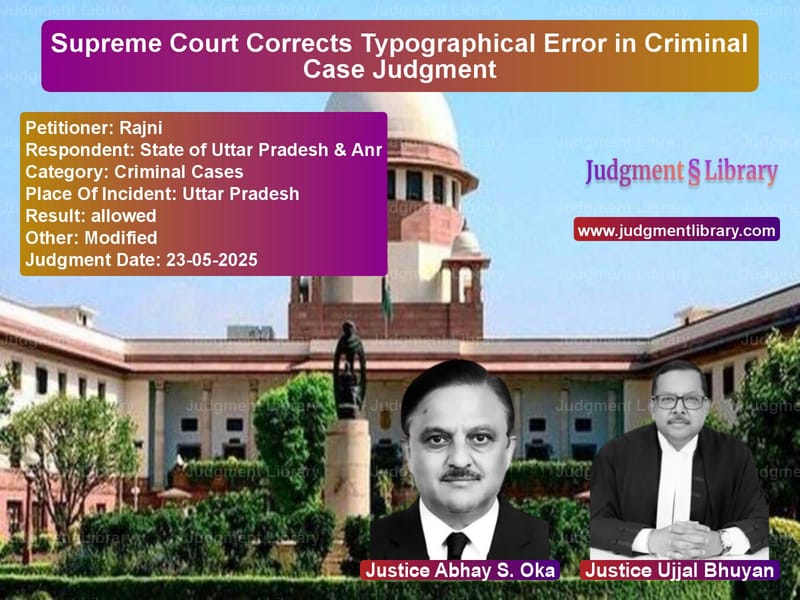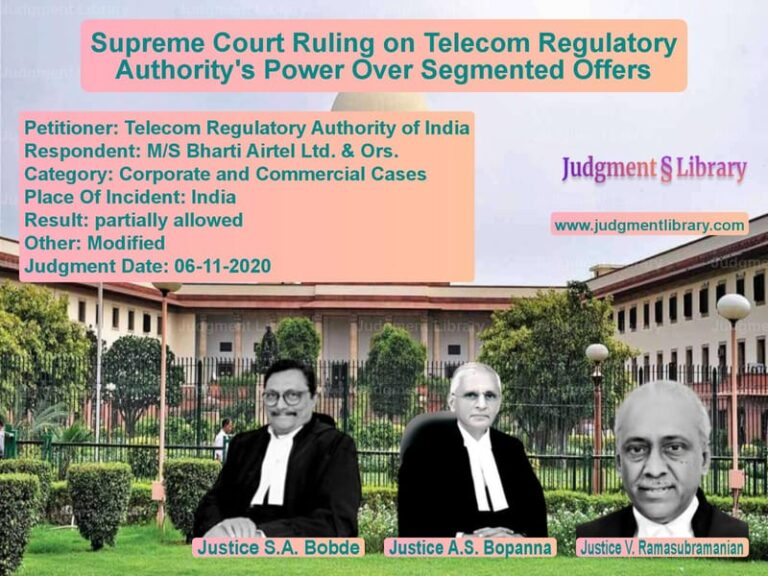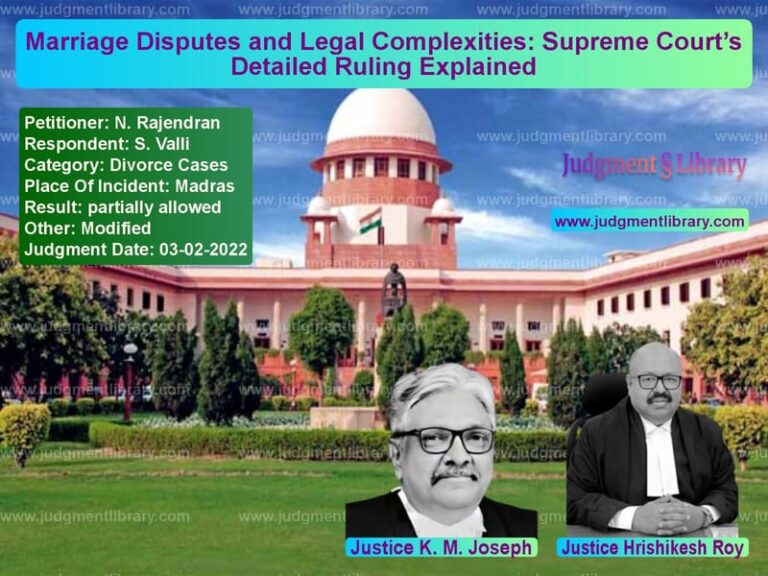Supreme Court Corrects Typographical Error in Criminal Case Judgment
In a brief but significant procedural order, the Supreme Court of India recently demonstrated the meticulous attention to detail that characterizes the Indian judiciary’s commitment to accuracy and precision in legal documentation. The case involving Rajni versus the State of Uttar Pradesh & Another, which came before the bench of Justice Abhay S. Oka and Justice Ujjal Bhuyan on May 23, 2025, highlights how even minor errors in court documents can have significant implications for legal proceedings and how the judiciary maintains vigilance in correcting such mistakes promptly. This correction order, though seemingly minor in scope, underscores the Supreme Court’s dedication to maintaining the integrity and accuracy of legal records, ensuring that every detail in judicial proceedings reflects the true facts and circumstances of each case.
The Nature of the Correction
The Supreme Court’s order addressed a specific typographical error that had appeared in paragraphs 27 and 29 of the judgment and order dated May 20, 2025. The error involved incorrect case numbers that had been transcribed in the original judgment. The Court noted in its straightforward order: “There is a typographical error in paragraphs 27 and 29 of the judgment and order dated 20th May, 2025. Instead of ‘Miscellaneous Case No.9/2020 in respect of Crime Case No.11/2020’, it has been typed as ‘Miscellaneous Case No.9/2000 in respect of Crime Case No.11/2000’.”
While this might appear to be a simple date correction—changing ‘2000’ to ‘2020’—the implications of such errors in legal documents can be substantial. Case numbers are fundamental identifiers in the judicial system, and incorrect references could potentially lead to confusion, misidentification of cases, or difficulties in tracking case histories. The Court’s prompt recognition and correction of this error demonstrates the judiciary’s proactive approach to maintaining the accuracy of legal records.
The Legal Proceedings
The case was listed before the Supreme Court as Criminal Appeal No. 603 of 2025, along with connected Criminal Appeal No. 2569 of 2025. The appellant, Rajni, was represented by Ms. Amita Singh Kalkal and Mr. Devvrat Pradhan, while the respondents, State of Uttar Pradesh and Another, were represented by Mr. Vikas Bansal, Dr. Vijendra Singh, Ms. Apurva Singh, and Mr. Praveen Chaturvedi. The presence of multiple legal representatives indicates the significance attached to the case by both parties.
The Court’s order was concise and direct, focusing specifically on the correction needed. The justices instructed: “The Registry to make the necessary correction and do the needful.” This directive to the Court Registry emphasizes the systematic approach the Supreme Court follows in maintaining accurate records. The Registry, as the administrative arm of the Court, plays a crucial role in implementing such corrections and ensuring that all official documents reflect the accurate information.
Importance of Accuracy in Legal Documents
The Supreme Court’s attention to this typographical error, though seemingly minor, highlights a fundamental principle of judicial administration: the critical importance of precision in legal documentation. In the Indian legal system, where precedent and case law form the backbone of jurisprudence, accurate case citations and references are essential for several reasons.
First, correct case identification ensures proper administration of justice. When cases are incorrectly cited, it can lead to confusion in future references, potentially affecting the rights of parties involved. Second, accurate documentation maintains the integrity of the judicial process, ensuring that every decision is properly recorded and can be reliably referenced in subsequent cases. Third, in an era where legal research increasingly relies on digital databases and automated citation systems, correct case numbers are essential for efficient information retrieval.
Read also: https://judgmentlibrary.com/cbi-cotton-msp-fraud-case-supreme-court-sets-aside-discharge-of-accused/
The correction from ‘2000’ to ‘2020’ is particularly significant because it affects the temporal context of the case. A case from 2000 would involve different legal frameworks, potential limitations, and contextual factors compared to a case from 2020. By ensuring this correction, the Supreme Court maintains the historical accuracy of its records.
The Correction Process in Supreme Court
The Supreme Court’s procedure for correcting errors in judgments is well-established, though not frequently discussed in public discourse. When errors are discovered in court judgments—whether typographical, factual, or legal—the Court has mechanisms to address them. The present case represents a common type of correction where the Court itself identifies an error and issues a corrective order.
Typically, such corrections can be initiated in several ways: through review petitions filed by parties, through suo motu recognition by the Court, or through administrative checks by the Registry. In this instance, the Court appears to have identified the error on its own initiative, demonstrating the thorough review processes that judgments undergo even after their pronouncement.
The instruction to the Registry to “do the needful” encompasses a series of administrative actions. This includes updating the digital records of the case, ensuring that all official copies of the judgment reflect the correction, notifying the concerned parties about the correction, and ensuring that the corrected version is the one that enters the official law reports and databases.
Broader Implications for the Legal System
While this correction order might appear routine, it reflects broader principles that uphold the integrity of the Indian judicial system. The Supreme Court’s vigilance in correcting even minor errors reinforces public confidence in the institution. It demonstrates that the Court takes its responsibility seriously and ensures that its records are accurate and reliable.
This attention to detail is particularly important in criminal cases like the present one, where the stakes are high, and the rights and liberties of individuals are involved. Accurate case references ensure that the history of each case is properly preserved, which is crucial for appeals, reviews, and future references.
Furthermore, in a legal system where judgments often cite previous decisions, correct case citations are essential for maintaining the coherence and consistency of jurisprudence. An error in a case number could potentially lead to misidentification of precedent, which could have ripple effects throughout the legal system.
The Role of Technology in Legal Accuracy
The Supreme Court’s correction order also highlights the ongoing challenges and opportunities in maintaining accuracy in legal documentation in the digital age. While technology has made it easier to produce, store, and retrieve legal documents, it has also introduced new potential sources of error, such as transcription mistakes, copy-paste errors, and digital miscommunications.
At the same time, technology provides solutions for maintaining accuracy. Digital systems allow for easier corrections and updates to documents, ensuring that the most current and accurate version is available to all stakeholders. The Supreme Court’s e-filing system, digital repositories, and online case status portals all contribute to maintaining accurate and accessible legal records.
The Court’s prompt action in correcting the typographical error demonstrates how traditional judicial diligence combines with modern administrative systems to uphold the standards of legal documentation.
Conclusion: Upholding Standards of Judicial Excellence
The Supreme Court’s order in Rajni versus State of Uttar Pradesh & Another, though brief, embodies the judiciary’s commitment to precision, accuracy, and excellence in all aspects of its functioning. By promptly addressing a typographical error in its judgment, the Court reinforces the importance of attention to detail in the administration of justice.
This case serves as a reminder that in the legal system, every detail matters. From the correct spelling of names to accurate case numbers, from precise legal terminology to proper citation formats, each element contributes to the integrity and reliability of judicial proceedings. The Supreme Court’s conscientious approach to correcting errors, no matter how small, sets a standard for the entire judicial system and reinforces public trust in the institution.
As the Indian legal system continues to evolve and modernize, this commitment to accuracy and precision remains fundamental. The Supreme Court’s correction order, while addressing a specific typographical error, ultimately reflects the broader values of diligence, responsibility, and excellence that characterize India’s highest judicial institution.
Petitioner Name: Rajni.Respondent Name: State of Uttar Pradesh & Anr.Judgment By: Justice Abhay S. Oka, Justice Ujjal Bhuyan.Place Of Incident: Uttar Pradesh.Judgment Date: 23-05-2025.Result: allowed.
Don’t miss out on the full details! Download the complete judgment in PDF format below and gain valuable insights instantly!
Download Judgment: rajni-vs-state-of-uttar-prade-supreme-court-of-india-judgment-dated-23-05-2025.pdf
Directly Download Judgment: Directly download this Judgment
See all petitions in Judgment by Abhay S. Oka
See all petitions in Judgment by Ujjal Bhuyan
See all petitions in allowed
See all petitions in Modified
See all petitions in supreme court of India judgments May 2025
See all petitions in 2025 judgments
See all posts in Criminal Cases Category
See all allowed petitions in Criminal Cases Category
See all Dismissed petitions in Criminal Cases Category
See all partially allowed petitions in Criminal Cases Category







